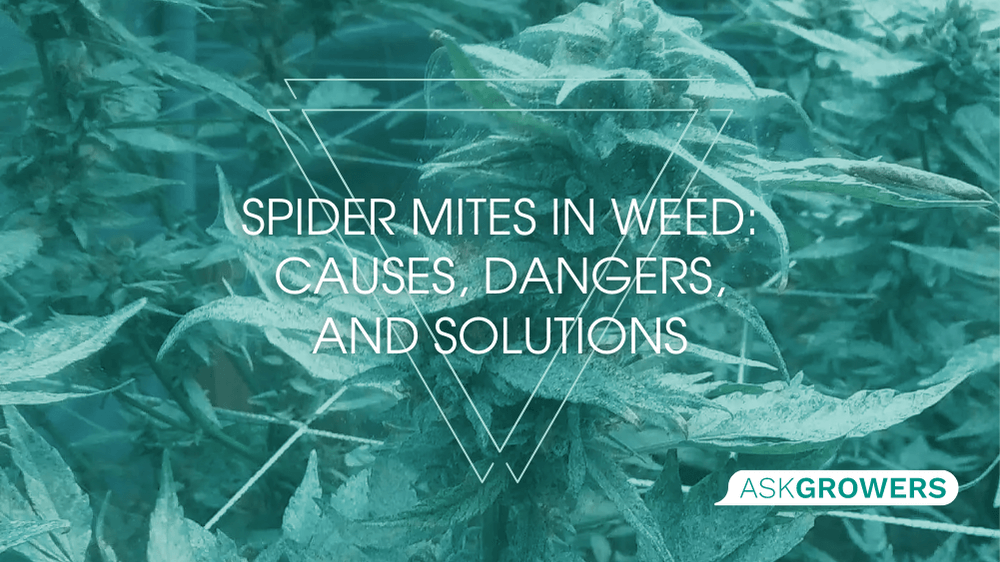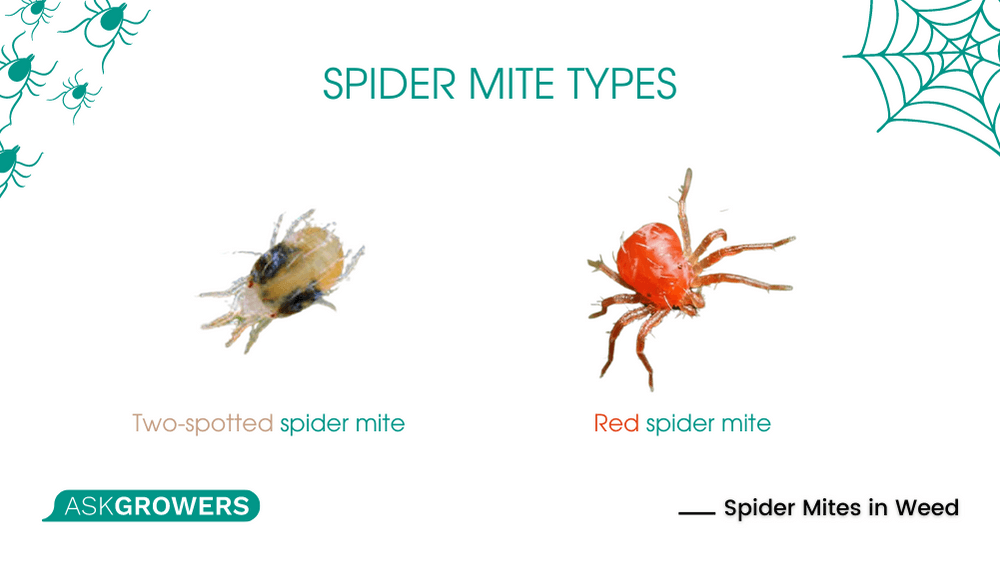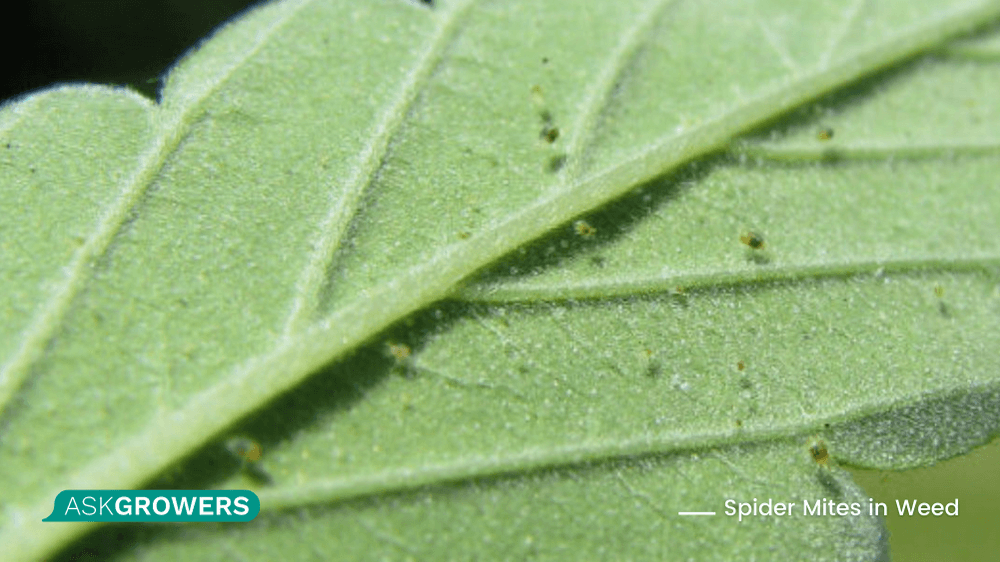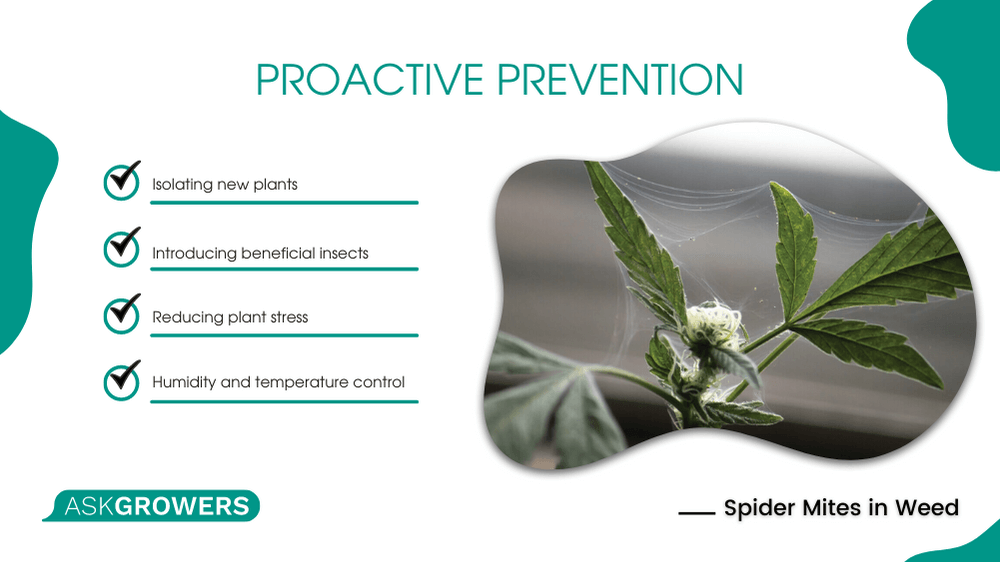Spider Mites in Weed: Causes, Dangers, and Solutions

Navigating the complexities of growing cannabis can be challenging, especially when confronted with pests such as spider mites. Indeed, these small, harmful creatures pose a significant threat to your plants. Predominantly, two species of spider mites attack the hemp plant: the two-spotted spider mite and the red spider mite. Detecting these mites on Cannabis early is critical to your plant's health and productivity. They can wreak havoc on your crops, from yellowing leaves to significantly reduced yields.
Cannabis Spider Mites: Types, Lifecycle, and Threats
Weed plant spider mites, tiny arachnids often less than a millimeter in length, are almost invisible threats to your cannabis. Despite their minuscule size, they can inflict significant damage if left unchecked. These creatures are so small that they are nearly undetectable without the aid of a magnifying glass or microscope, thereby presenting a significant challenge to growers.

Weed plant spider mites, tiny arachnids often less than a millimeter in length, are almost invisible threats to your cannabis. Despite their minuscule size, they can inflict significant damage if left unchecked. These creatures are so small that they are nearly undetectable without the aid of a magnifying glass or microscope, thereby presenting a significant challenge to growers.
A keen eye and quick action are essential for preventing infestations and ensuring the successful growth of your plants. This article aims to provide you with an effective guide to identifying, controlling, and eradicating these menacing mites. Let's delve deeper into understanding these creatures and adopting strategies to safeguard your cannabis plants against them.
Read Also: Cannabis Deficiencies: Symptoms and Solutions
Types
The two-spotted spider mite and the red spider mite are two notorious culprits in cannabis cultivation. Though they share a good deal of similarities in terms of their life cycles and behaviors, they also exhibit some crucial differences that are important for accurate identification and effective pest control.
Understanding the nuances between these two mites is key to their early detection and the safeguarding of your plants. Both species can cause extensive damage to your cannabis crops, but each carries distinct traits and preferences that can influence your choice of eradication strategies.
Lifecycle
Both these cannabis mites undergo the same stages: egg, larva, two nymph stages (protonymph and deutonymph), and adult. The complete life cycle of a spider mite, from egg to adult, usually spans one to two weeks, depending on the species and environmental conditions.
-
Egg: The female spider mite lays her eggs on the underside of leaves, typically along the veins. These eggs are small, round, and transparent.
-
Larva: The eggs hatch into six-legged larvae, which start feeding immediately.
-
Nymph stages: The larvae molt into the first nymph stage (protonymph), then molt again into the second nymph stage (deutonymph). They have eight legs in these stages and continue feeding and growing.
-
Adult: After the second molt, they reach the adult stage, where the females are ready to lay eggs, and the cycle begins anew.
Two-spotted Spider Mite vs. Red Spider Mite
| Two-Spotted Spider Mite | Red Spider Mite | |
|---|---|---|
| Color | Light green to yellow with two distinct dark spots on the body. The color can change to orange or brown in stressful conditions. | Reddish-brown to strong red color. |
| Size | Approximately 0.4 mm in length. | Slightly larger than the two-spotted spider mite, up to 0.5 mm in length. |
| Preferred Climate | Prefers hot and dry conditions, often a problem in indoor grows or hot summers. | Can survive in a wider range of temperatures and humidity but is usually more prevalent in cooler, outdoor environments. |
| Damage Signs | Leads to chlorotic spots, yellowing leaves, and, in severe cases, leaf drops. Webbing is commonly present. | The damage is often less extensive due to slower reproduction rates. |
| Reproduction Rate | Extremely high. A single mature female can lay up to 20 eggs a day and can live for two to four weeks. | Slightly slower than the two-spotted spider mite but can still lead to large populations if left uncontrolled. |
Threats
Despite their differences, both species of mites feed by piercing plant cells and sucking out the contents, which leads to the distinctive damage they cause. They can be difficult to eradicate once established due to their rapid reproduction and ability to develop resistance to pesticides. Early detection and intervention are vital to effectively manage and control these pests. Understanding their life cycle and distinguishing characteristics can greatly assist in these efforts.
Identifying Spider Mites on Weed Plants: What Are the Signs?
Spider mites may be minuscule, but their impact on your cannabis plants can be massive. Beyond being mere nuisances, they pose a real threat to your crop's health and productivity. Such damage can significantly affect the therapeutic properties of cannabis, including its pain-relieving, anti-inflammatory, and anxiety-reducing qualities. By arming yourself with knowledge and remaining vigilant, you can safeguard your plants from these pests. Ensuring the optimum conditions for your cannabis growth isn't just about plant health; it's also about maintaining the medicinal potency that makes cannabis such a valued plant.

Staying ahead of spider mites keeps your plants thriving and medically effective. So, as the saying goes, "knowledge is power," and when it comes to safeguarding your cannabis plants from infestations, understanding the telltale signs of spider mites is a significant part of the battle.
Visual Signs
At first glance, a plant affected by spider mites may appear to have a mottled or speckled look. These are the visible signs of spider mites feeding, caused by cell damage as they pierce the plant tissue and suck out the contents. These small specks, or stipplings, may initially appear light-colored or yellowish, eventually turning brown as the damage worsens.
One sure sign of spider mites on weed flowers, especially on marijuana growing in a greenhouse, is the presence of tiny webbings. These creatures, being part of the spider family, are known to produce thin, silky strands, particularly when their population becomes dense. If you spot delicate web-like structures clinging to the underside of your plant's leaves or around the buds, it's a strong indication of a spider mite invasion.
For growers who notice an unusual pattern of damage late into their growing cycle, you might be dealing with spider mites on weed harvest. The infestation can lead to a decline in yield quality as the mites draw out essential nutrients from the plant. Under a severe attack, leaves might dry out, curl up, and eventually fall off, causing significant harm to the plant's photosynthesis capability and overall health.
Spider mites on marijuana can be particularly challenging to spot due to their tiny size. A magnifying glass or a handheld microscope can be extremely helpful tools in this scenario. The adult mites appear as minute specks crawling on the plant's surface, typically found on the underside of the leaves. They can be different colors, but two-spotted spider mites have a distinct pair of dark spots on their body.
Environmental Specifications
Environmental conditions greatly influence the reproduction and plant damage of spider mites. They thrive in hot, dry conditions and can reproduce rapidly under such circumstances. If the humidity levels are low and the temperature is around 80–90 degrees Fahrenheit, you have an environment conducive to a spider mite explosion. Hence, maintaining a balanced temperature and humidity within your growing space can help in controlling these pests.
Remember, catching the signs of mites on weed as early as possible is crucial. Once the population is high, they can develop resistance to pesticides, making them much harder to eradicate. Regularly inspect your plants, especially when the conditions are prime for mite development. Use a magnifying tool to spot them, and look for discoloration and webbing.
How to Get Rid of Spider Mites Cannabis: Helpful Tips
Successfully growing marijuana means more than just nurturing fluffy buds; it’s also about managing and protecting those ripe buds from spider mites. Here are some useful tips to keep these pests at bay and to ensure the health and vitality of your cannabis plants.

Proactive Prevention
Preventing mites on marijuana is arguably the most effective strategy. Maintaining cleanliness in your growing area is crucial. Regularly sanitize your hands, tools, and plant containers to avoid inadvertently introducing pests. Effective natural strategies for preventing spider mites on plants comprise:
-
Isolating new plants
-
Introducing beneficial insects
-
Reducing plant stress
-
Controlling humidity and temperature
It's crucial to isolate any new plants, as spider mites are tiny and can often evade a simple visual check. By keeping these plants separate for a period of at least two weeks, you can ensure they are pest-free. During the flowering stage, such predator insects as ladybugs, pirate bugs, green lacewings, and assassin bugs thrive, provided the environment suits their survival, thereby ensuring a mite-free grow box.
Aim to maintain optimal plant health by providing sufficient hydration and essential nutrients to keep stress levels at a minimum. Stressed plants are more susceptible to infestations. If you're growing your plants indoors or within a greenhouse, regulating temperature and relative humidity can deter spider mites. They have a preference for warm conditions, so reducing the temperature and maintaining humidity levels between 55% and 65% can contribute to a spider-mite-free environment.
Read Also: How Long Does It Take to Grow Marijuana – Stages of Growth
Combatting an Infestation
If you've detected spider mites on your cannabis plants, swift action is required. For minor infestations, a strong water spray can dislodge the mites from your plants. Follow this with insecticidal soap or a solution of neem oil and water, sprayed thoroughly on all plant surfaces. These are natural pesticides that can effectively kill the mites without harming your plants.
In severe cases, you might need to resort to miticides. When using these products, rotate between different types to prevent the mites from developing resistance. Always follow the manufacturer's instructions.
Bear in mind that one treatment often isn't enough. Spider mite eggs can hatch a few days after the adult mites are killed, so repeated treatments are necessary to ensure complete eradication.

 Growing
Growing



.png)



 (1).png)

.jpg)





Be the first and share your opinion
Write a Review